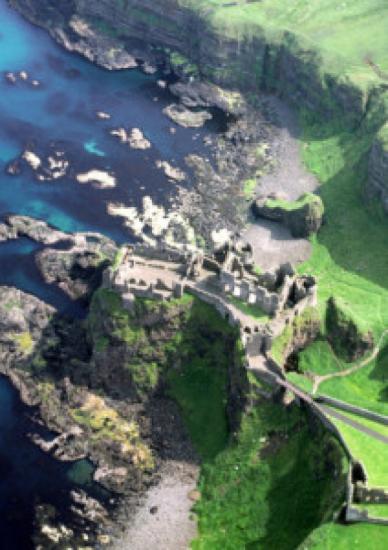Our own little Pompeii beneath Dunluce Castle
Rebecca Black
http://www.newsletter.co.uk/news/local/our-own-little-pompeii-beneath-dunluce-castle-1-4142991

Aerial photograph of Dunluce Castle looking eastwards across the castle towards Gallows Hill. The cast was originally located on the basalt promontory and gradually expanded over two centuries. Pic by Northern Ireland Environment Agency
IT may seem unlikely driving past Dunluce Castle today, but just 600 years ago, it was a thriving settlement where homes were richly decorated with tiles and its residents decorated with jewellery imported from the northern Europe.
Following a series of archaeological digs conducted by Colin Breen from the University of Ulster at Coleraine, a new book has revealed there is a lot more to Dunluce Castle than simply the remains that we see today.
Mr Breen’s team carried out digs in 2008, 2009, 2010 and 2011 in the fields in the castle as well as the surroundings fields in search of the lost town of Dunluce.
Mr Breen found that Dunluce Castle was probably first built in the fifteenth century by the MacQuillan family, known as the lords of the Route. The original castle was built between 1490 and 1513, only the ground floor of the original gate house now still stands.
The castle was cutting edge at the time, boasting small windows known as gun loops where shots could be fired out, but harder to fire in. The use of pistols in Ireland is first recorded in the fifteenth century.
The MacDonnell family took over the castle in the 1550s and extended the castle rebuilding the gatehouse and building turrets. Rocks from the nearby Giants Causeway were used in the facing of the walls. In the 1580s, a loggia was added reflecting a fashion in Scottish castles at that time, looking towards Italian style.
However the discovering of the plantation town of Dunluce was what excited archaeologists most.
In May 1608 Randal MacDonnell, on receiving grants to settle Ulster, began to establish settlements across his estates. They were designed to act as centres of trade and industrial activity, populated by new settlers brought in from Scotland as well as existing Irish inhabitants. As part of this, he set up a Saturday market at Dunluce.
Dunluce town grew to include stables and a brew house.
By 1611 documentary sources record a “good house of stone with many lodgings and other rooms”, by the 1620s there were at least 40 houses and 240 inhabitants, By 1630 there were more than double with 521 men recorded, they were adult male tenants of English and lowland Scotttish extraction, capable of bearing arms in the event of an Irish insurrection. A sandstone sign which once adorned a doorway bore the name Michael Henderson.
The central area of the town was a diamond and the streets were cobbled.
Some of the artefacts found by the archaeologists include a 1547 coin which is thought may have been worn by the descendent of an earlier merchant as decoration. Evidence of high quality decoration for the insides of houses was also found with a sherd of a delicately painted blue, white, yellow and green tile from the Netherlands discovered.
A Blacksmiths workshops was also found.
However the settlement was destroyed by the Irish during the 1641 rebellions. It was burned to the ground according to testimony gathered in the 1641 depositions. The 1659 census backs this up recording a very different population, just 46 residents in the town. Of these 15 were classified as English and 31 as Irish. The town had been completely abandoned by the 1680s.
Mr Breen said Dunluce’s connection between Ulster and Scotland had made it an important lynchpin in a larger archaeological project exploring links between north Antrim, Londonderry and the western Isles.
Environment minister Alex Attwood wrote a foreword to the book praising Mr Breen and his team’s work at Dunluce.
“Dunluce Castle has stood on the north Antrim coast for well over 400 years; it is undoubtedly one of the best known monuments in Northern Ireland. The striking cliff-top ruins and their spectacular location have combined to make this an iconic site, used to promote Northern Ireland throughout the world,” he said.
“Over four seasons for excavation, it became clear that the castle itself had a complex history of building, alteration and adaptation, but also that the early seventeenth century town of Dunluce lay buried, but very well preserved, in the fields outside the castle gate. This is a fascinating prospect - our own little Pompeii buried just below ground surface.”
As a result of the project, the Northern Ireland Environment Agency now own the two fields where the plantation town lies and has not ruled out further excavations of it in the future.